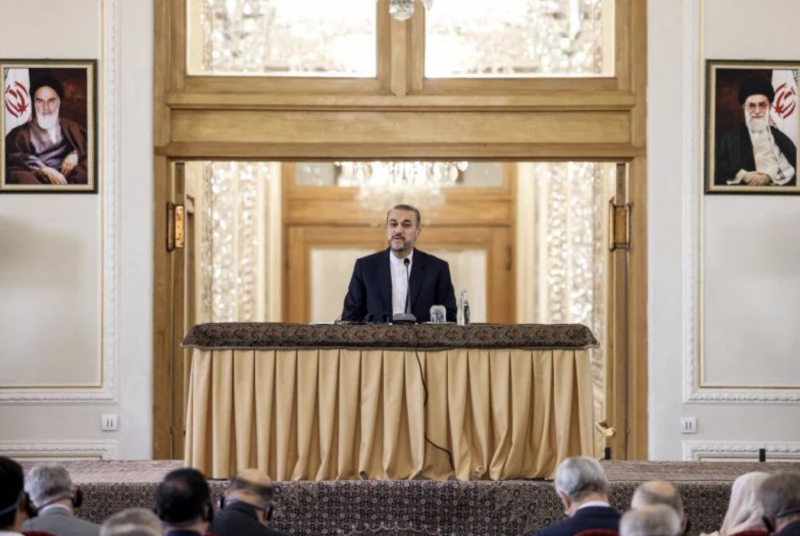
A press conference by Iranian Foreign Minister Hossein Amir-Abdollahian after Iran's attack on Israel. (Credit: Atta Kenare/AFP)
Whatever unfolds next, the night of April 13, 2024 will stand as a significant date in the annals of the Islamic Republic of Iran.
Iran’s drone and missile attack on Israel — dubbed Operation True Promise — signifies both a precedent and a pivotal moment. Yet, the extent to which it will fundamentally reshape Iranian strategy in the years ahead remains uncertain.
For over four decades, Iran has relied on a combination of militias and missile infrastructure across the Arab world to advance its regional influence and bolster its deterrence capabilities.
Since Oct.7, however, this strategy has reached its zenith and constraints.
Never before has this network been as extensively mobilized across multiple fronts simultaneously in service to Iranian power.
Yet, concurrently, never before has it faced such concerted targeting and erosion, resulting in a partial loss of its deterrent efficacy and exposing vulnerabilities within the Islamic Republic.
Indeed, Hamas’s military wing has suffered significant damage in Gaza, while Hezbollah has endured a barrage of strikes over the past six months. Additionally, the Houthis and Iraqi militias find themselves exposed to American airstrikes, and Israel has taken the liberty of targeting the leadership of the Iranian al-Quds Force in Syria and Lebanon.
Even if Iran perceives strategic victories in the continued presence of Hamas in Gaza, the cumulative losses are substantial.
Nonetheless, this dynamic has compelled Iran to react, seeking to alter the rules of engagement.
Following an attack on its territory on April 1, during an Israeli strike targeting an annex of the Iranian consulate in Damascus, Iran has opted to shift gears.
A failure?
The attack carried out on Saturday night was both spectacular and large-scale, yet carefully calibrated to mitigate escalation.
Symbolically, Iran left an indelible mark, holding the entire region in suspense for several hours. The sight of Iranian missiles and drones traversing the skies over the Al-Aqsa Dome will linger in collective memory.
However, the Iranians failed to inflict significant damage on their adversaries from a military standpoint.
While some may view this outcome as a failure, the Iranians predominantly employed drones, which took hours to reach Israeli territory.
Moreover, they provided advance notice to several parties regarding the date and scale of the operation, refraining from deploying Hezbollah, their primary weapon against Israel.
The interception of 99 percent of Iranian drones and missiles is the result of these strategic decisions as well as Israel’s and the US’s military superiority.
Politically, Iran’s actions have inadvertently bolstered Israeli Prime Minister Benjamin Netanyahu’s position.
Israel finds itself once more backed by widespread Western support, while the ongoing carnage in Gaza fades into the background.
The regime survival
The night of April 13 was a crucial test for Iran.
It felt akin to an artist, after years of boasting about their talent, stepping onto the stage for the first time. The theatricality expected of such an event was impeccably executed. However, the overall outcome was a mixed bag.
Iran is far from a paper tiger; it holds the status of a regional power with an unparalleled capacity for destabilization.
Yet, its power appears constrained when juxtaposed with that of its primary adversaries.
Iran has ventured into significant risk-taking territory, a move that greatly risks backfire.
The US seemingly persuaded its Israeli ally against immediate retaliation. However, it appears improbable that Israel will simply let the matter rest.
This attack, orchestrated by Israel’s primary adversary on their territory, is a significant provocation. Israel is likely to seek retaliation to prevent a recurrence of such an incursion.
One question remains: Will Israel respond with measured restraint, or will it opt for a disproportionate escalation?
Should it choose the latter, the entire region — including Iran — may end up on edge.
Operation “True Promise” aims to create “a new equation with Israel,” said Islamic Revolutionary Guard Corps (IRGC) Commander Hossein Salami on Sunday.
“From now on, if Israel attacks Iranian interests or citizens anywhere, Iran will respond,” he added.
This new strategy presupposes that Iran has succeeded in restoring its deterrent capability, which is far from self-evident.
Otherwise, the Iranian regime runs the risk of direct confrontation with Israel — and potentially the US — which could jeopardize the Iranian regime’s survival.
The primary takeaway from the past six months for Iran is clear: Without nuclear weapons, relying solely on its allies may not suffice to ensure its survival in the most extreme circumstances.
Moreover, as Iran edges closer to possessing nuclear capabilities, the likelihood increases that Israel will resort to a large-scale operation within Iranian territory.
Despite its inherent resilience, Iran remains equally fragile.
This article was originally published in L'Orient-Le Jour. Translated by Sahar Ghoussoub.